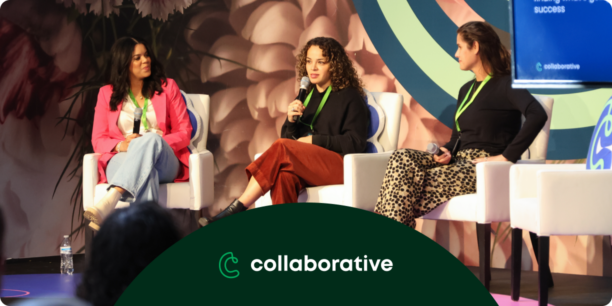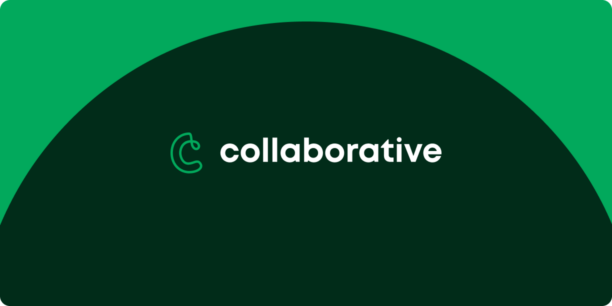Buy vs. Build: How to Streamline Your Nonprofit’s Donor Data Pipeline

This blog was written in collaboration with Sam Heckendorf, Data Scientist, and Alexandra Wilson, Business Intelligence Lead of Classy’s Data Science and Analytics team.
In our previous post, we explored the critical role of a modern data stack in transforming nonprofits’ fundraising approaches. By creating a smooth flow of data, this overhaul enables organizations to maximize donor contributions, target new supporters, nurture existing relationships, and personalize each individual’s giving experience.
We identified three common bottlenecks in turning raw data into actionable insights:
- Siloed systems: When internal departments fail to coordinate their efforts, it can result in duplicated work, data accessibility issues, and difficulties adapting to new requirements.
- Inconsistent reporting: Without standardization across teams, stakeholders lack alignment on definitions and metrics. Additionally, using siloed systems for data management and reporting can lead to inconsistencies in organizational key performance indicators and uncertainty in data validity.
- Data swamps: When organizations lack consistent data governance practices, data lakes can become unmanageable, disorganized, and inaccessible, rendering the data practically unusable.
Below, we’ll explore how opting for a point-and-click approach is the most effective route to combat these bottlenecks and streamline donor data pipelines. Specifically, we’ll cover how opting to buy rather than develop in-house systems can generate immediate returns.
Let’s dive in.
Unpacking the Buy vs. Build Debate
Before we delve into managing and organizing your nonprofit’s data infrastructure, let’s first understand why nonprofits have historically favored building extract, transform, load (ETL) pipelines over purchasing point-and-click tools.
What Are ETL Tools and Why Are They So Important?
ETL tools streamline data integration processes, enhance data quality, and improve accessibility to organization-wide data. In this post, we’ll concentrate on the E (extract) and L (load) components.
Extraction is the first step in the process. It refers to pulling data from sources like databases, APIs, or cloud services and storing it in repositories like data warehouses, data lakes, or cloud storage. Engineers and analysts can then apply transformations—like deduplication and data cleansing—using built-in capabilities of tools such as dbt (data build tool).
After cleaning the data, the final step is loading it into a target system like a data warehouse, data mart, or customer relationship management (CRM) software. This step is crucial because it makes the data available in business intelligence tools like Tableau or Looker. Teams can also use reverse ETL tools, like Salesforce, to extract and load data back into a CRM.
Understanding the Circumstances That Led Nonprofits to Build
Over the past decade, the idea of running a data-driven organization has evolved. Previously, the data landscape involved manual data entry, complex in-house integrations, and siloed decision-making because point-and-click tools were scarce or expensive.
Consequently, organizations built in-house systems for full developmental control, which cost long-term efficiency and adaptability.
With the advancement of ETL tools, off-the-shelf tools like Fivetran and Census have simplified the manual process of orchestrating data flows from one source to another. Instead of coding how to extract data across sources automatically, apply transformations with complex queries, and load the data into a database, a developer can simply configure these processes using prebuilt connections provided by Fivetran.
With the click of a button, Fivetran’s connectors allow organizations to extract data from disparate sources—like Salesforce and Google Analytics—and transform them in a data warehouse using SQL for organization-wide data consumption.
For instance, an organization can extract donor insights, like donation amounts, from its fundraising platform and combine them with campaign-specific cause details. This approach helps create a more personalized email marketing strategy. It also enables the organization to segment its audience, ensuring that messaging is relevant and resonates with donors based on their past interests and contribution amounts.
Secondly, adopting new tools often comes with a price tag. Stakeholders might not immediately grasp the direct correlation between data reliably flowing through systems and increased fundraising. In fact, many may question, “How does fixing data pipelines contribute to our mission?”
As we explore below, ensuring the integrity of donor data pipelines plays a crucial role in fulfilling your mission, but learning why and how to advocate for it is the first step to securing the resources you need.
The Strategic Impact of Buying Data Solutions
Although the value of data integrity may not be immediately clear to your organization, we know firsthand the impact of a buy vs. build integration approach. Some of the primary benefits include:
- Saving time to focus on what matters: ETL tools can make data more readily available and reliable, enabling you to plan, iterate, and report on fundraising success. This helps fundraisers understand that giving follows a specific seasonal pattern and that individual organizations have unique seasonality, making time crucial when planning major events and seasons.
- Lowering overhead and knowing when things break: ETL tools provide your team full visibility of donor data pipelines using low to no-code solutions. This means you might not need additional staff to manage data influxes. These tools also help monitor data costs and usage because, unlike manual scripts that can be a black box of unknown costs, ETL tools offer visibility that can save money.
- Expediting time to gain insights and mobilize fundraisers: ETL tools are essential for rapidly streaming data into your marketing systems, enabling you to segment and create appeals efficiently. By syncing new data into your systems frequently, even sub-hourly, these tools optimize the time to gain insights, empowering fundraisers to act promptly on these insights.
These tools also simplify data access and usage for stakeholders not directly involved in technical aspects, such as writing and executing code. This is crucial as these stakeholders prioritize data accuracy and timeliness over technical processing and delivery details.
Key Steps for Adopting a Buy-over-Build Data Pipeline Model
There are numerous ways to structure your tech stack to address your organization’s challenges. While the tools available are plentiful, the fundamental principles remain consistent.
In the graphic below, we outline the core components of a smart data stack fueled by a point-and-click approach.
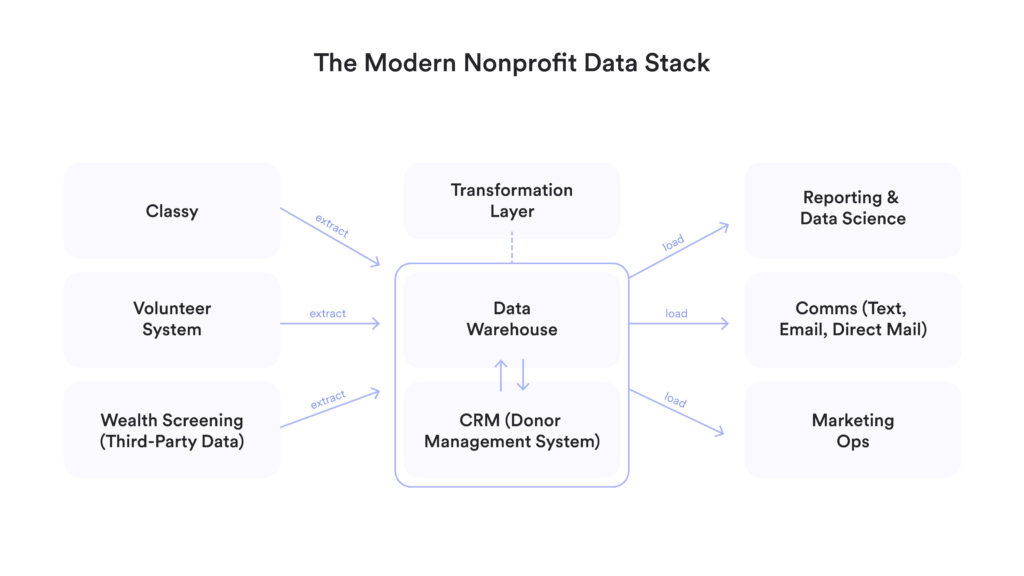
The journey starts with data sources, fueling your fundraising efforts. Store this data where you can transform and interpret it, then move it to your source of truth. Clean data then flows into your marketing system for segmented appeals or your visualization tool to share insights. The arrows depict the data flow across systems for processing.
Even without a data warehouse, you can integrate tools in your tech stack to communicate. However, this integration may only go so far in maximizing your CRM’s effectiveness. Nonprofits often directly integrate tools like Salesforce, Omatic, and Virtuous, but without a data warehouse, they miss out on fully leveraging their data.
How to Get Started
Earlier, we discussed how adopting new ETL tools can efficiently connect systems.
First, ensure that critical data sources automatically feed into your central data repository, where transformation occurs. Centralizing data in one location is crucial for effective data management.
Next, ensure data integrity across your reporting and marketing systems by seamlessly exchanging data between these tools and the central data repository. Here are a few examples of how to ingest and activate data across your user-facing systems:
- Utilize an extraction tool, like Omatic, to automatically extract data from Classy and integrate it into a donor data warehouse or CRM.
- Set up a Zap in Zapier to automate the data transfer into a donor data warehouse or CRM. Classy’s Zapier integration can help.
- Interpret the results of a marketing A/B test in your reporting system by sending marketing results back into your single source of truth via Census.
- Get Slack notifications when a donation exceeding $1,000 comes through Classy via the Zapier integration.
Implementing these practices will significantly accelerate your progression through data maturity. By connecting donor trends and patterns across your systems, you’ll segment and activate more effectively, thanks to the enhanced visibility into the donor lifecycle.
See It in Action
In December 2023, Classy hosted its inaugural Data Symposium. We gathered leaders from Team Rubicon, The Salvation Army, City of Hope, The Leukemia & Lymphoma Society, Cedars-Sinai, and more to explore what’s possible in data and innovation for the philanthropic sector.
Classy’s data team noted several recurring themes from the numerous conversations:
- Cloud migration: Modern organizations are moving away from on-premise databases and CRMs and opting for cloud-based solutions for increased flexibility and scalability.
- Automated identity resolution: Exploring methods to automatically deduplicate records and link constituents to existing profiles has helped organizations streamline data management processes.
- Streamlined donation processing: Improving the donation processing speed to reduce the time taken for supporters to receive their first welcome email is critical in the modern fundraising ecosystem, necessitating faster and more frequent data processing pipelines.
- Unified customer data platform (CDP): Implementing a CDP to consolidate activity logs and segmentation allows organizations to track supporter engagement comprehensively and in real-time.
- Intelligent marketing and outreach: Leveraging the CDP to segment donors effectively based on their activities and preferences, organizations enable personalized asks and recruitment efforts while maximizing the impact of marketing campaigns.
These nonprofits recognize the importance of leveraging technology to enhance fundraising and supporter engagement. By investing in transforming their tech stacks, they’re taking a strategic approach to adapt to the evolving landscape of nonprofit operations. These investments signify a commitment to improving data management, enhancing communication with supporters, and achieving greater impact in their respective missions.
Additionally, these principles guide our approach at Classy when considering where our fundraising platform fits within your tech stack. Classy’s open API fuels our extensive integrations library, featuring Google Analytics 4, Zapier, Omatic, Salesforce, and others. This capability allows you to link various data sources and eliminate data silos effortlessly.
Learn More about Our IntegrationsPracticing What We Preach: Classy Studio
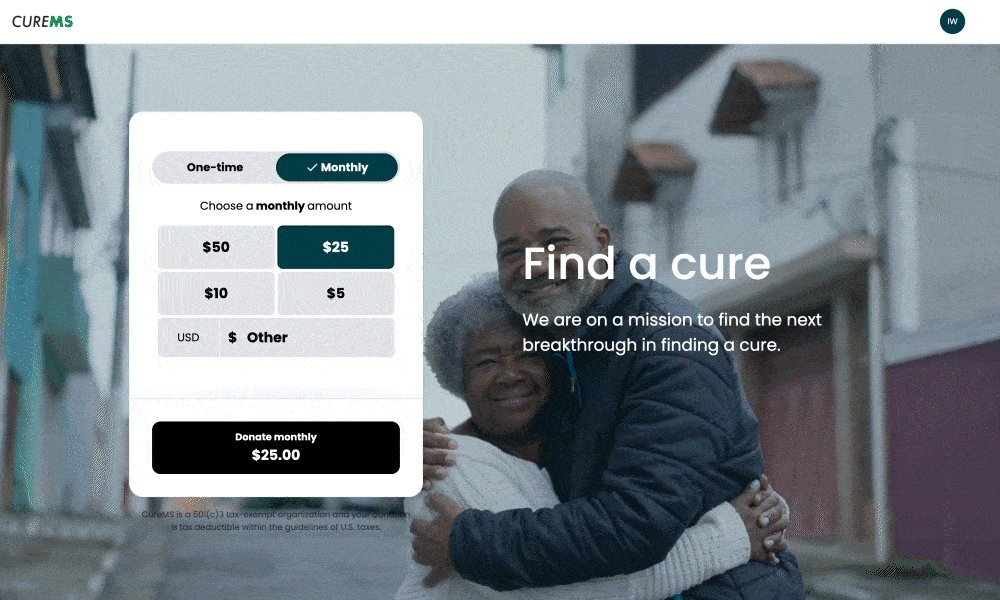
Let’s consider an example using our latest product launch, Classy Studio.
When a campaign powered by Classy Studio gets launched and receives donations, ETL tools allow the Classy data team to automatically ingest this product data, like donation volume, into our single source of truth, where we can explore how to make our product smarter and work harder for our nonprofit customers.
By embracing a modern data stack approach, we harness the full power of our data to inform decisions and predict future behavior.
Revolutionizing Fundraising with Modern Data Stack Solutions
In the modern data-driven nonprofit landscape, the challenges of inconsistent reporting and managing multiple data sources can seem daunting. However, by embracing modern data pipeline solutions, organizations can use the transformative power of easy data ingestion and integration.
As we’ve explored, the value of easy data ingestion extends beyond mere convenience. It empowers fundraisers to save time, lower overhead costs, and expedite time to insights, enabling them to focus on what truly matters: maximizing the impact of their fundraising efforts.
We encourage you to examine how your nonprofit’s data flows across systems and consider the potential benefits of incorporating no-code solutions into your tech stack. By embracing these tools, you can elevate your organization’s fundraising capabilities and embark on a journey toward greater efficiency and effectiveness.
Copy Editor: Ayanna Julien
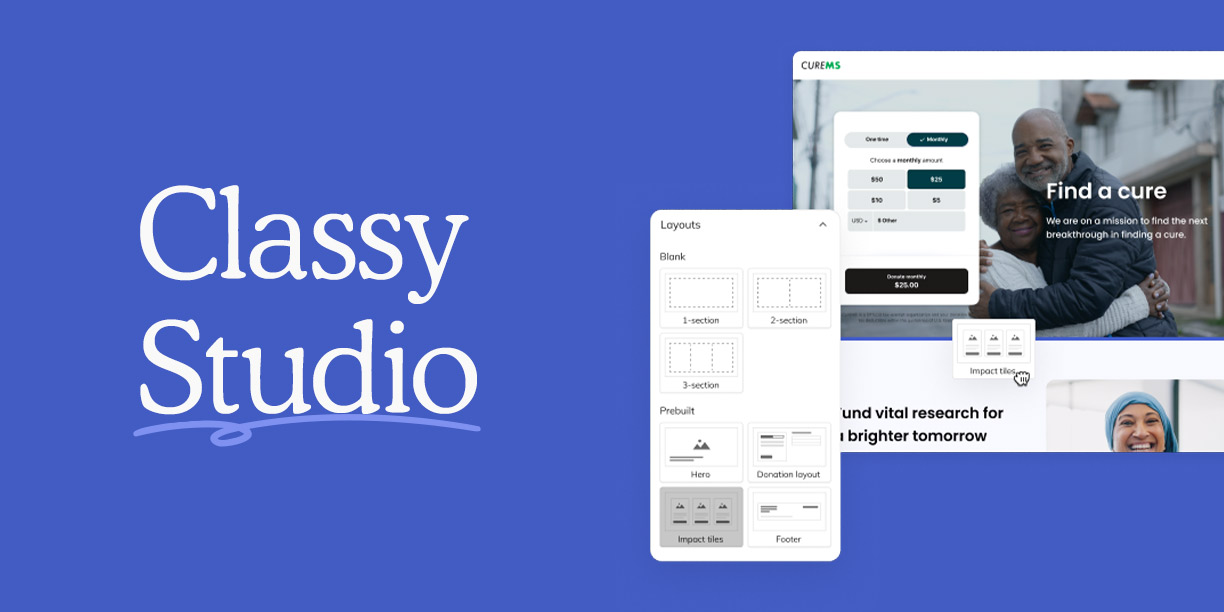
Unleash Your Online Fundraising Potential with Classy Studio

